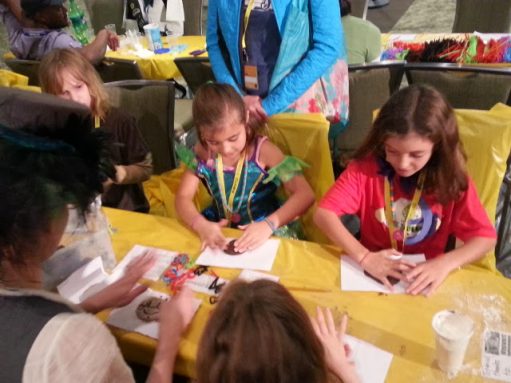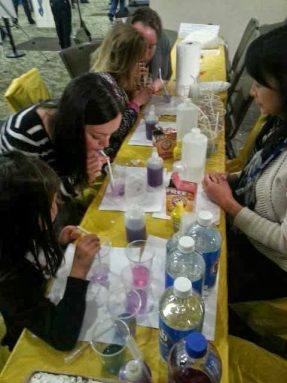Everyone’s a scientist at GeekGirlCon!
Some young researchers brought science activities to a popular Geek convention so kids of all ages could do hands-on science.
Share this:
- Share via email (Opens in new window) Email
- Click to share on Facebook (Opens in new window) Facebook
- Click to share on X (Opens in new window) X
- Click to share on Pinterest (Opens in new window) Pinterest
- Click to share on Reddit (Opens in new window) Reddit
- Share to Google Classroom (Opens in new window) Google Classroom
- Click to print (Opens in new window) Print
I just got back from GeekGirlCon in Seattle, Wash. A yearly meeting on all things geeky, it “celebrates and honors the legacy of women contributing to science and technology.” The focus may be on women, but the center was filled with men and women, boys and girls. Everywhere, people sold geeky merchandise (from comic books to Coraline-themed perfume), sat through talks on topics such as women in gaming and modeled their Tardis dresses. My fellow scientists and I did our geeky part: We set up a Do-it-yourself (DIY) ScienceZone.
At a series of bright yellow tables, we spent the day doing fun science activities. We made slime out of glue and Borax, changed the color of a liquid with our breath, made craters out of marbles and made ‘fossils’ from coffee grounds. Why? To help kids and adults learn about science while having fun.


Raychelle Burks came up with the idea for the DIY ScienceZone at last year’s GeekGirlCon. “I was in the gaming zone, which is an awesome space,” she says While enjoying this space where you could build your own game, Burks “realized we need a space where you could build your own science.”
As an analytical chemist, she knows a lot about science. Right now, she’s a postdoctoral researcher at Doane College and the University of Nebraska. That means she already has a PhD. (Her work at the university now focuses on how to detect chemicals important for forensics, to help solve crimes.)
For this year’s meeting, Burks got some friends together, men and women from all over the country. These included physicists, a museum worker, biologist, physiologist (me) and more. Each contributed ideas for how best to share science with kids. Then Burks set up a donation page on the Internet. By harnessing social media, she raised over $6000 to help pay bringing our zone to the Seattle event. It paid for our supplies and the airfare to fly us zone workers in from all over the country.
It was especially important to Burks that the zone workers be scientists of all stripes and types. “A lot of people don’t know a scientist,” she says. She suspects most people hear the term and picture “dudes from the Big Bang Theory. I wanted to give people a space where they could interact with real scientists.”
She believes that is it essential that kids and adults see scientists of all backgrounds. Burks says that if you see a scientist who looks like you, doing a job that you’ve always wanted to do, “then you think it’s attainable.” Seeing that scientists don’t look like Einstein can help people realize that they can be scientists, too.
And it certainly worked. The DIY ScienceZone was a huge success. More than 300 people wandered through our ScienceZone. Children and adults alike took part in genetic taste tests, extracted DNA from strawberries and took home nature notebooks. GeekGirlCon has already asked ScienceZone to come back next year. And Burks has big plans for that and more.
“I would love to expand it into other events,she says. She’d like to bring it to events on the East coast and Midwest. Her goal: to expose as many people as possible to the fun of science and discovery. You know, those Eureka moments.
She doesn’t just want to make everyone choose a career in science. She wants instead to show how science already is part of everyone’s life, whether they are a scientist, farmer, auto mechanic, stay-at-home dad or lawyer. Everyone can explore more about their world, using science — and learn and have fun on the way.
I’m pretty sure that everyone who came to our ScienceZone had fun. I certainly did! As a participant, I got to help kids make “neurons” out of pipe cleaners. Then I explained what these cells are, how they work and what they do. Along the way, kids and parents asked me what I did for a living, why I liked science and lots of other great questions.
Who knows, with any luck the DIY ScienceZone could be coming soon to a city near you!
Power Words
acid A chemical that increases the level of hydrogen ions (H+) in a solution.
base A chemical that produces hydroxide ions (OH-) in a solution.
borax Also called sodium borate, it’s a salt of boric acid. Chemists use it to make buffer (neutralize) acidic solutions and many manufacturers add it to detergents.
crater A large, bowl-shaped cavity in the ground or on the surface of a celestial body, such as a planet or moon. Craters typically are caused by an explosion or the impact of a meteorite or other celestial body.
forensics The use of science and technology to investigate and solve crimes.
fossil Any preserved remains or traces of ancient life. There are many different types of fossils: The bones and other body parts of dinosaurs are called “body fossils.” Things like footprints are called “trace fossils.” Even coprolites — specimens of dinosaur poop — are fossils.
ion An atom or molecule with an electric charge due to the loss or gain of one or more electrons.
neuron (or nerve cell) Any of the impulse-conducting cells that make up the brain, spinal column and nervous system. These specialized cells transmit information to other neurons in the form of electrical signals.